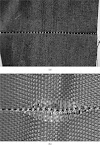Fabric Inspection Procedure in Garment Industry
Bhagyashree Shivdas & Jyoti Kupelur | Fashion Technology, DKTE Society’s Textile and Engineering Institute | February 24, 2020
btextiles19@gmail.com
Fabric inspection is one of the important pre production process. The main purpose of fabric inspection is to identify defects and inconsistencies early in the production process, so that time and money will not be wasted over time in repairing a defect or writing defective goods.
In garment industry fabric store department does the inspection procedure. For that purpose generally these 12 parameters are checked.
Those are following,
1. 4 Point system
2. Shade band card
3. Shade report
4. Face side approval
5. Hand feel
6. Shrinkage report
7. CSV
8. Colour fastness
9. Nap direction/ One way
10. Bowing and skewing
11. Width report
12. Fusing seam slippage
These are 12 parameters discussed as per following -
1. 4 Point System - In apparel industry for checking fabric quality 4 point system is used. It is the calculative method of total penalty points for total defects found in fabric roll. Penalty points giving based on defects or defect length.
Size of defects and its penalty points-
| Size of Defects | Penalty Points |
|---|
Formula for calculating points per 100 sq. meter
Points per 100 sq. meter = Total penalty points *100 *100 / Width of fabric (cm) * Total length (meters)
Acceptance points – Generally less than or equal to 40 points per 100 sq. meters are accepted.
2. Shade Band Card - For the inspection process shade band card is prepared as per the different shades like A, B, C, D. And get approval for all shade band before next procedure. It is helpful to making marker and in fabric layering.
3. Shade Report - To avoid shade variation (difference in colour) in the fabric, shade report is prepared using fabric swatch.
4. Face Side Approval - Face Side of fabric is checked with approved swatch card as it is given by merchant. This process assures that spreading and cutting are done as per the face marking according to the buyer requirement.
5. Hand Feel - Along with Face Side Approval, hand feel is also being checked as per approved swatch card.
6. Shrinkage Report - Shrinkage is the process in which a dimensions of fabric becomes smaller than original size of fabric. Shrinkage may happen either width wise, length wise or both. Sponging is the process to control shrinkage in the fabric.
Shrinkage % = (Before Dimension - After Dimension) *100 / Before Dimension
7. CSV (Centre to Selvedge Variation) - For marker making CSV report is important. To find out Centre to Selvedge Variation following procedure is used. If CSV is present then prepare CSV marker .
| 1 | 2 | 3 | 4 |
|---|
Above is the sequence for centre to selvedge variation testing.
| 3 | 1 | 4 | 2 |
|---|
| 2 | 4 | 1 | 3 |
|---|
The cut parts are rearranged in above manner and shade variation is checked.
8. Colour Fastness - Colour Fastness means how much colour can be resist by changing of brightness and darkness to some from outside factors. Colour Fastness assessment is done by visually comparing the difference in colour between untreated and treaded samples. Colour Fastness is also checked by with wet or dry rubbing in order to determine the resistance of the colour to rubbing.
9. Nap Direction / One Way Direction – It is subjective method which is checked for proper spreading. Because improper nap create defected garment.
10. Bowing and Skewing - Bowing and Skewing are the fabric defects in which weft threads are not directly perpendicular to warp threads. In bowing weft thread makes curves and in skewing weft thread makes angular displacement.
11. Width Report - Marker planning is done by considering width. Along with 4 point system width is measured 3 times at the initial, middle and final stage.
12. Seam Slippage - Seam Slippage is nothing but pulling away or separation of fabric at the seam.
This inspection procedure followed in garment industry and result is given to CAD department. According to result CAD department prepare marker.













0 Comments
If you have any doubts, please don't hesitate to ask